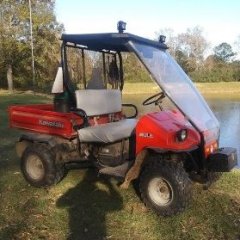-
Similar Topics
-
By Kingfish
The conversion took about 350lbs. off the vehicle. It never rode great, but now I feel every crack in the road. I have backed off spring compression nut to the point just under where they would move around if suspension was at full extension, but it is still very stiff. I would like to put some softer coilover springs on it, but I have no idea what the spring rate is with the original springs so I would just be guessing on what to order. Does anyone have the data for the original spring compression rate? I am willing to give up a little ground clearance for a softer ride. Right now when sitting still the rear suspension is at or near full extension and the rear tires have several degrees of camber which will cause uneven wear if allowed to continue in this state.
-
By hetovi
Hello everyone.
I recently bought a Can-Am Ryker and I'm looking to customize it with some accessories. I’ve seen a lot of options out there but wanted to get some recommendations from fellow riders.
What are the must-have accessories for comfort, style, or performance?
Specifically, I'm considering a windshield and better footpegs—are these worth the investment?
Also, any thoughts on storage solutions like saddlebags or rear cases?
Would love to hear your personal experiences with any mods you’ve done.
-
By Browner010
Recently I had an overheating issue on my 2022 Coleman Outfitter 550 (Hisun UT550) and to check to make sure it was fixed I took it out for a ride around the block. After a couple cycles on the LED coolant meter, I took it for a couple mile ride and on my way back I heard a loud metallic snap then a grinding noise. It was still able to move under its own power but very slowly. I was about 2 blocks from the truck so 'I limped it home and up onto the trailer. I know I need to tear it apart and look for what broke, but anyone have a guess as to where to start? I'm seriously getting tired of this damn machine! 750 miles on it and already replaced the belt, wet clutch, primary clutch, clutch roller weights among a few other things. Seriously, this friggin machine has spent more time on the lift than on the road. I thought I bought this new because it was from the owner of a tractor supply, but he registered it under the stores name making me the 2nd owner voiding any and all warranties.
Any Ideas what to look for would be appreciated.
Thanks
-
By Tony P
Twice my hisun has been driven a few miles and turned off back at home. Get back on it same afternoon and console is dead, no lights.
Have 12.7 vdc at battery and fuses are good. I hear relays click in the fuse box and main relay clicks but everything is dead.
Any ideas on what this may be? I've seen this problem before on this forum but it never finished.
Any help is always appreciated. Thanks in advance!
-
By mac66
Apparently, these are Hisun or at least they use Hisun engines. I can't find much info on them online yet. Ran across a used one with just 100 miles on it as a very reasonable price. Just curious.
Okay, more info...they are owned by Textron Corp who also owns Bell Helicopter, Cessna & Beechcraft aircraft, Ez-Go & Cushman and Arctic Cat and a bunch of other companies.
So are thy cheap Chinese crap machines or are they good to go?
-







Recommended Posts
Create an account or sign in to comment
You need to be a member in order to leave a comment
Create an account
Sign up for a new account in our community. It's easy!
Register a new accountSign in
Already have an account? Sign in here.
Sign In Now